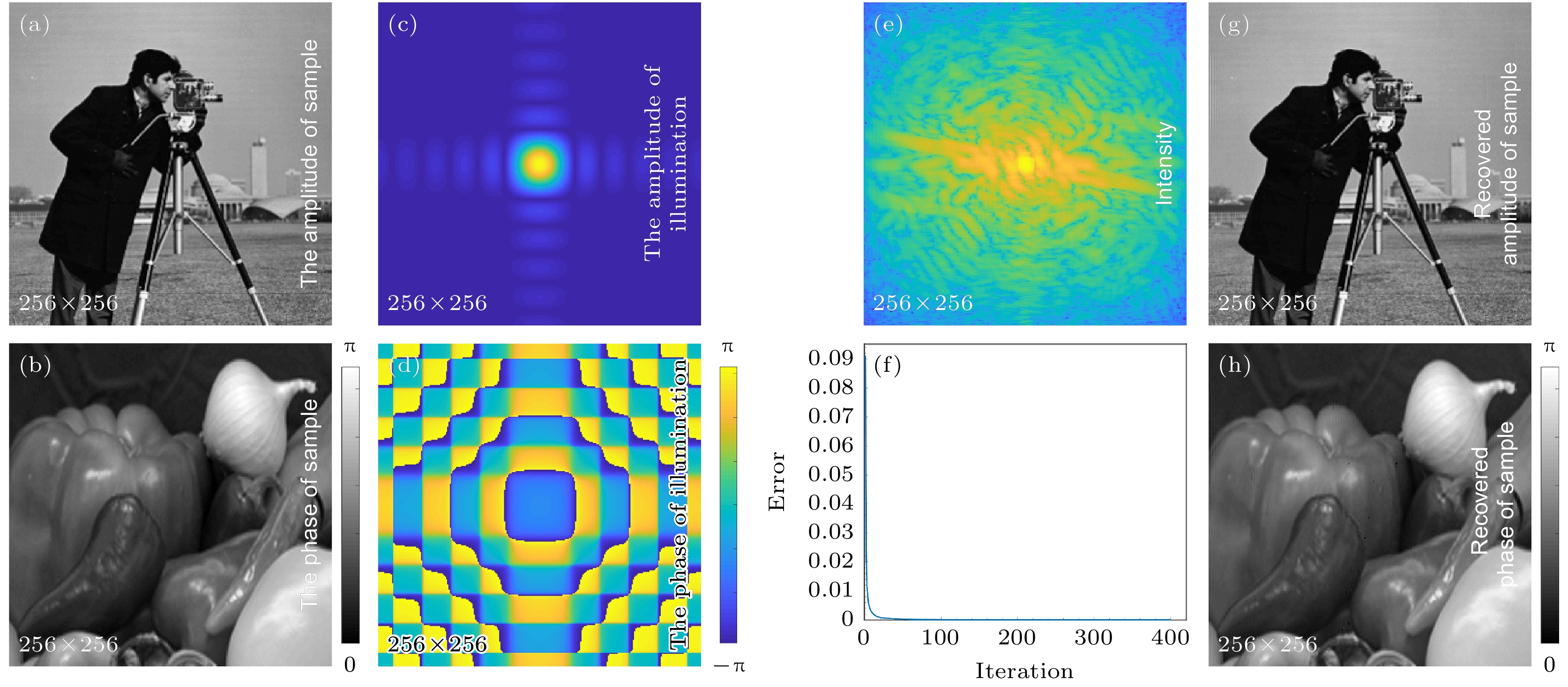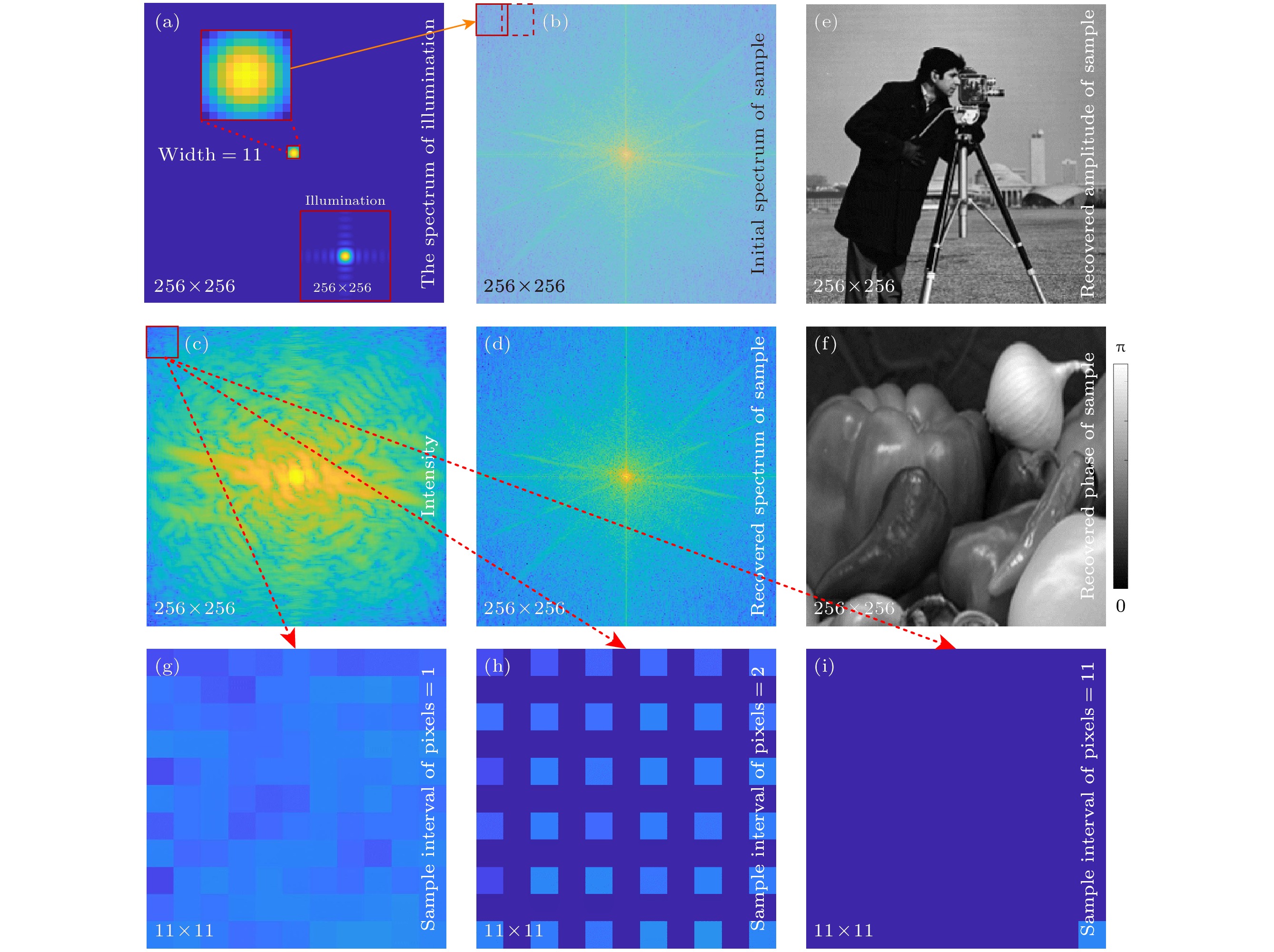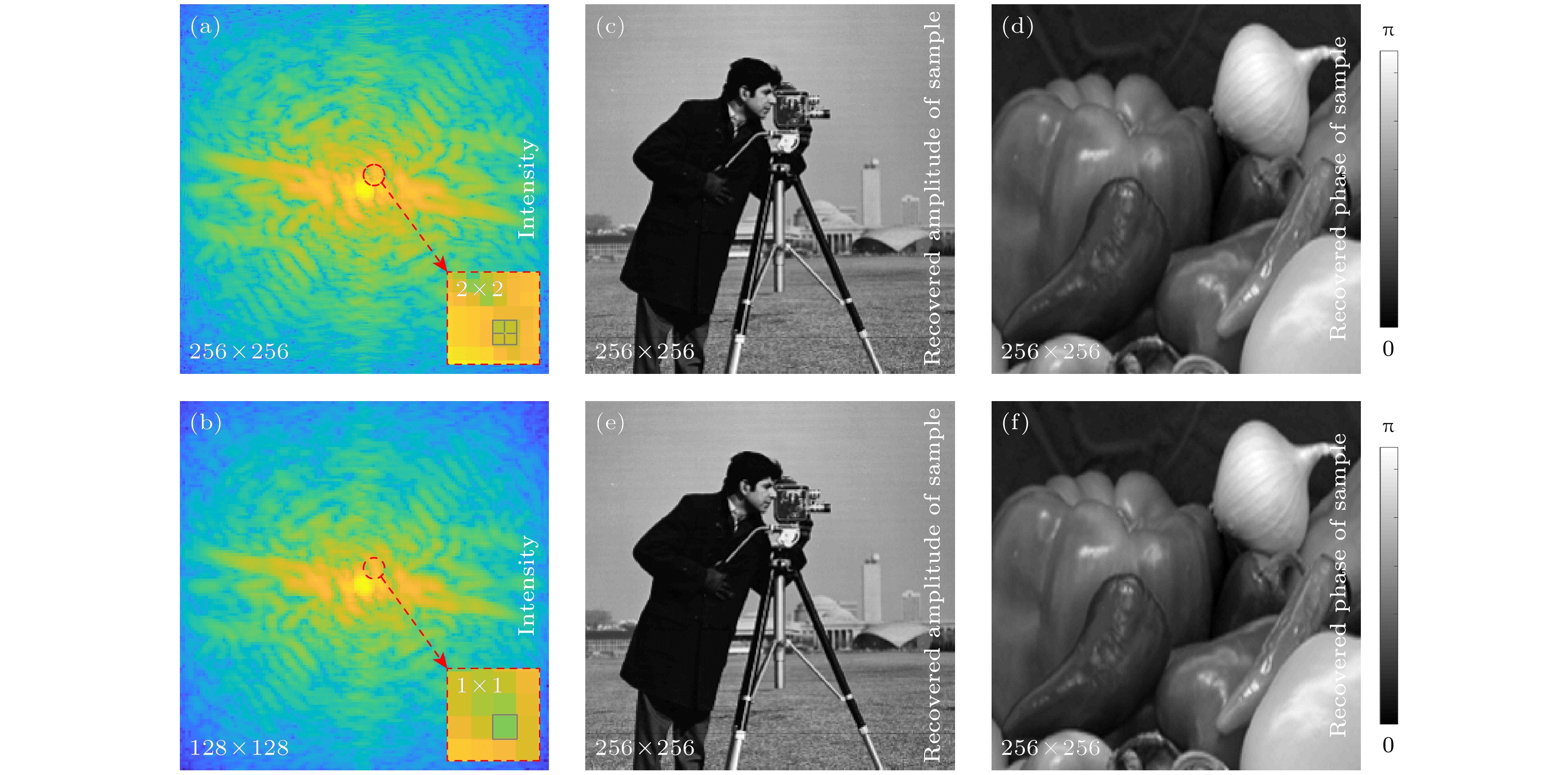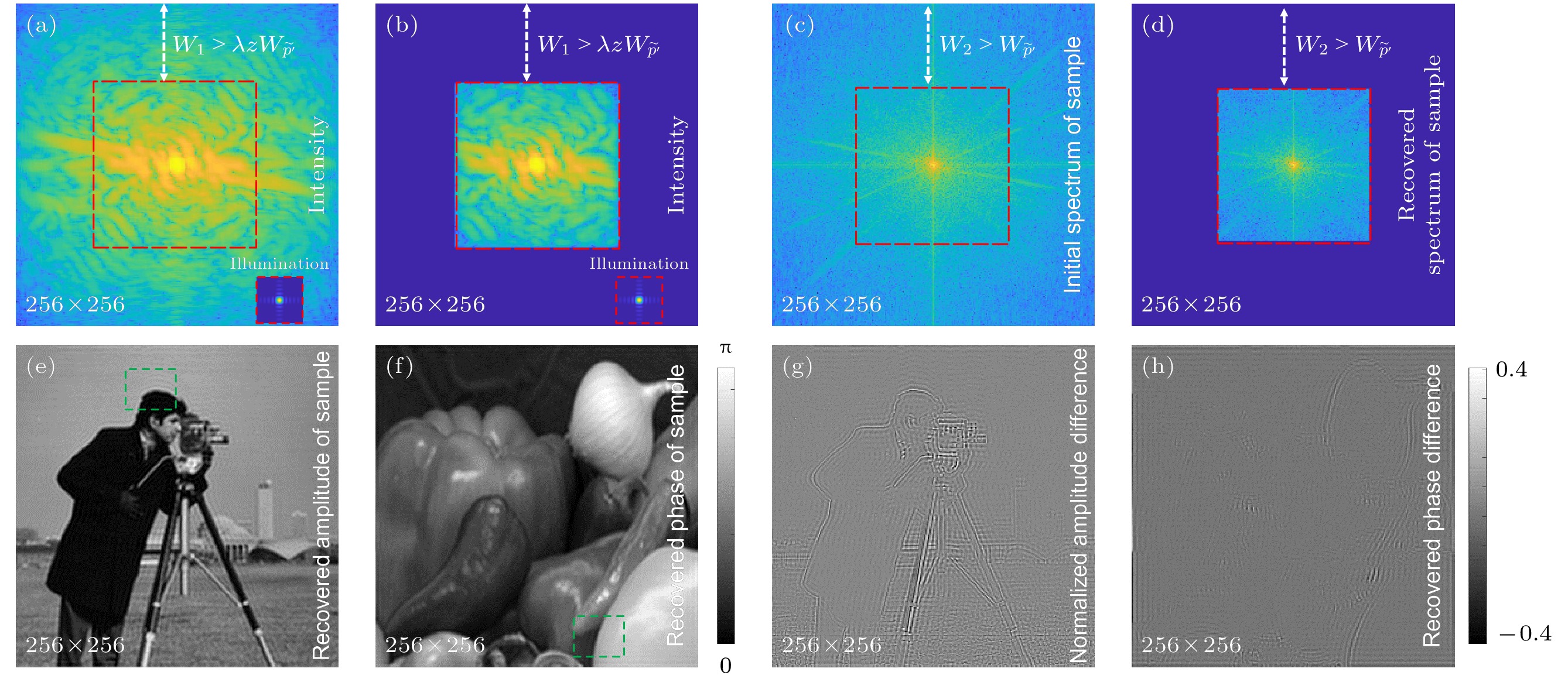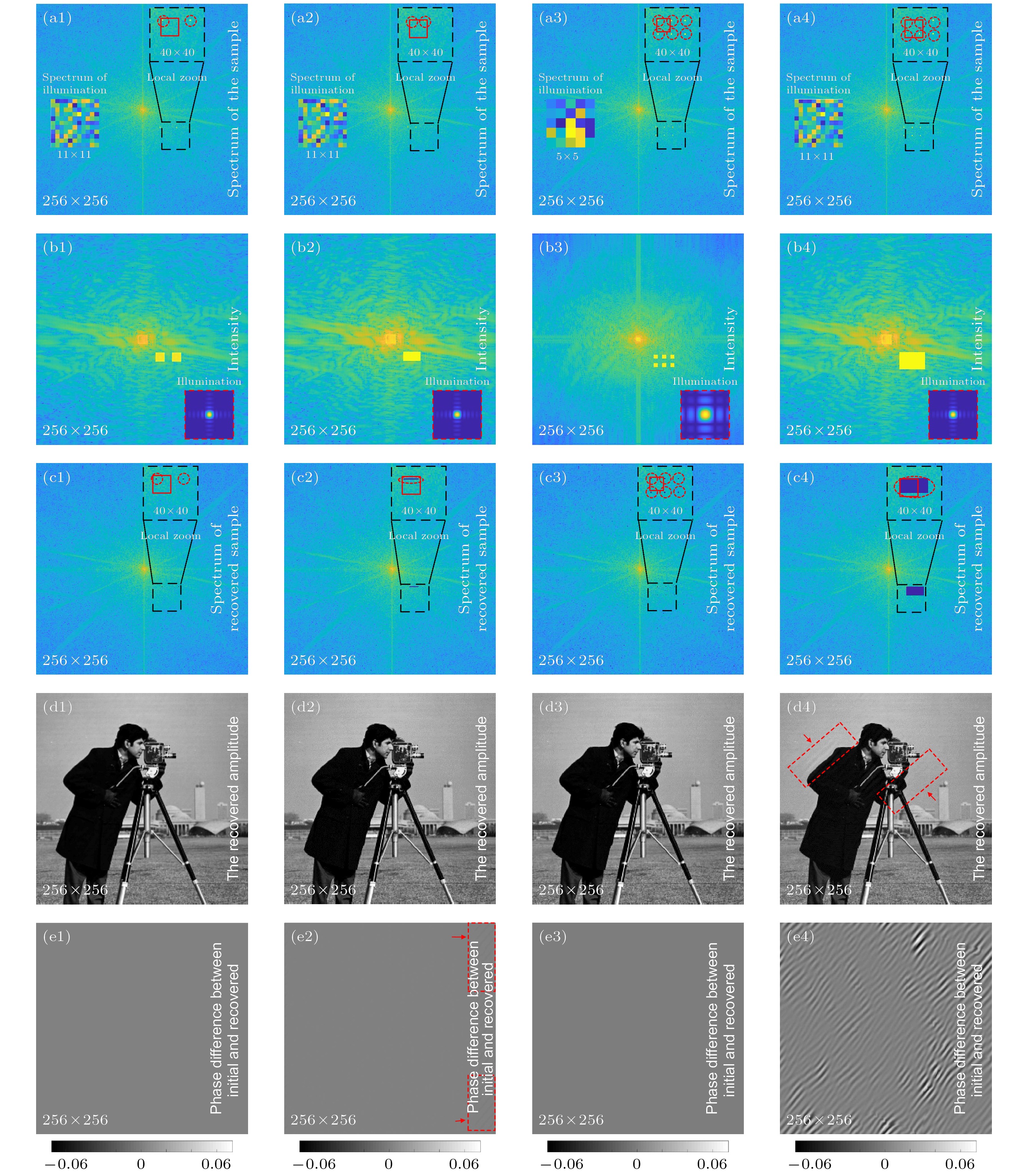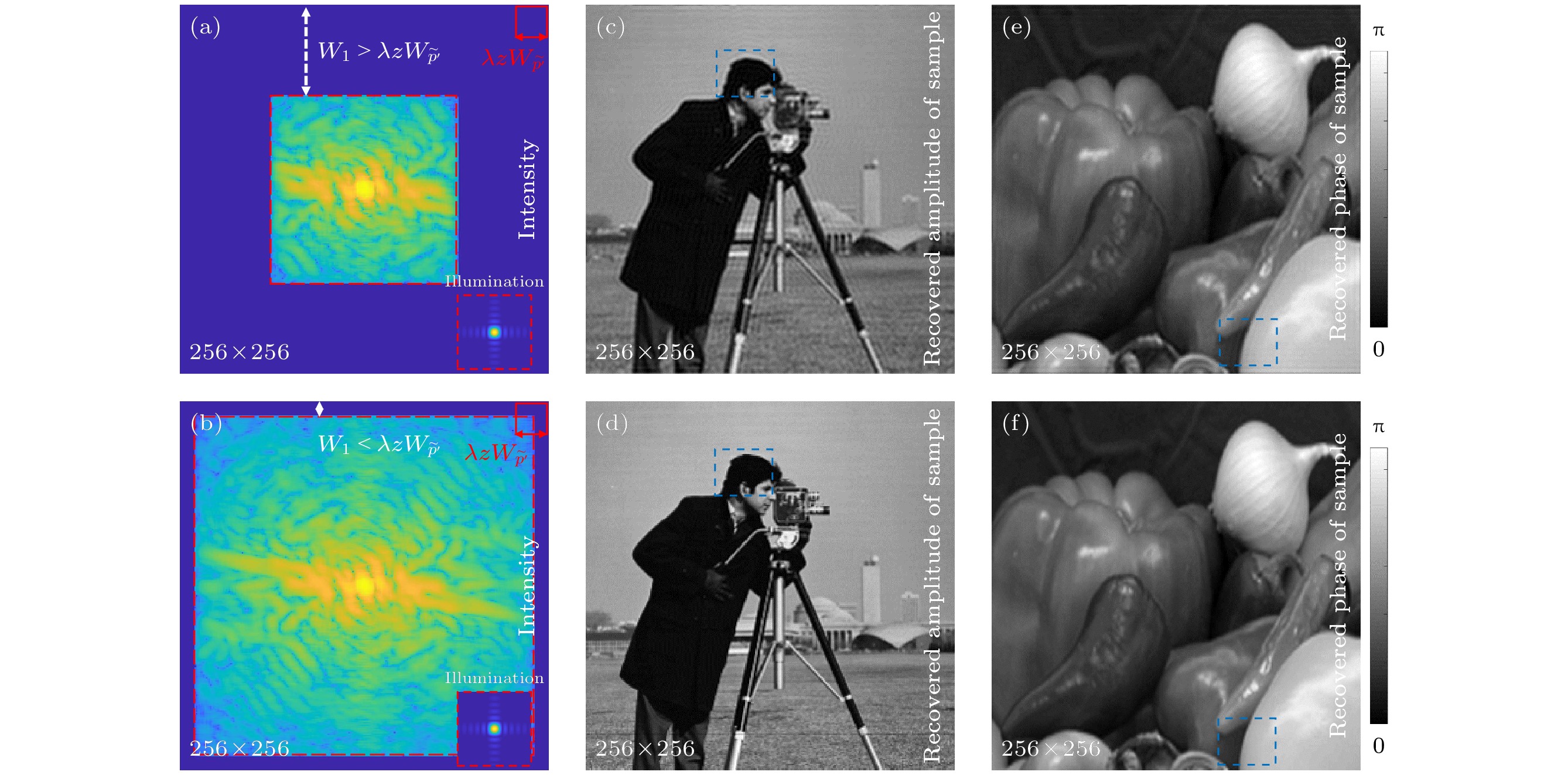-
从叠层相干衍射成像的解析求解模型出发, 通过在频域中将叠层相干衍射成像描述为待测样品与照明光空间频谱的线性方程组, 将探测器的光电参数和线性方程组的个数以及每个方程的未知数个数直接关联. 根据方程组存在唯一解的条件, 从理论上定量分析叠层相干衍射成像对探测器采样间隔、靶面宽度、像元尺寸、灵敏度和动态范围等关键光电参数的要求以及图像重建所受影响. 通过数值模拟, 对理论分析和预测的正确性进行了数值验证, 得出了参数不理想情况下叠层相干衍射成像仍能获得高质量重建像的物理机制, 对于提高重建质量和改进实验装置具有直接促进意义.An analytical solution model for ptychographic iterative engine (PIE) is proposed. In this model, PIE can be described as a system of linear equations between the sample and the illumination in the frequency domain. This system of linear equations ( AX = B ) is derived with the spectrum of the illumination as the coefficient ( A ), the spectrum of the sample as the unknown ( X ), and the intensity of the diffraction pattern as the vector ( B ). Hence, the sample can be recovered by solving this linear system. In PIE, the detector (such as Pike F-100, AVT) has a large resolution, meaning that 1000 × 1000 linear equations can be generated by recording a single pattern. It is still the case, however, that the number of obtained equations is smaller than the number of unknowns, leading to the inability to obtain a unique solution about the sample. Relative motions of sample and illumination, can generate more diffraction patterns to construct a sufficient number of linear independent equations. For coefficient ( A ), since the initial illumination is known, the illumination after shifting can still be obtained by recording its shifting distance. Hence the unique solution for the sample can be directly obtained by solving this linear independent system of equations. Simultaneously, the photoelectric parameters of the detector have a significant influence on the imaging quality of PIE. Using this linear system, the photoelectric parameters of the detector can be characterized by the number of linear equations and unknowns in each equation. According to the conditions that there is a unique solution in the system of equations and the requirements of the photoelectric parameters (such as pixel sampling interval, width of target surface, pixel size, sensitivity and dynamic range), the influence of the reconstruction for PIE is quantified theoretically. Obviously, the numerical simulation results based on this theory not only verify the correctness of the theoretical analysis and predictions, but also reveal the physical mechanism of recovering high-quality results in imperfect photoelectric parameters of detector, which can contribute to improving the quality of their reconstruction and optimizing the experimental setup.
-
Keywords:
- detector photoelectric parameters /
- phase retrieval /
- coherent diffractive imaging /
- ptychographic iterative engine
更正: 探测器光电特性对叠层相干衍射成像的影响 [物理学报 ]
齐乃杰, 何小亮, 吴丽青, 刘诚, 朱健强. 更正: 探测器光电特性对叠层相干衍射成像的影响. 物理学报. doi: 10.7498/aps.73.239901
[1] Guo Y, Han H Y, Wang L W, Zhu Y R, Gao X W, Yang Z G, Weng X Y, Yan W, Qu J L 2022 Appl. Phys. Lett. 121 023701
 Google Scholar
Google Scholar
[2] Wang Z, Zheng W, Hsu C Y S, Huang Z W 2015 Appl. Phys. Lett. 106 033701
 Google Scholar
Google Scholar
[3] Fiolka R, Shao L, Rego E H, Davidson M W, Gustafsson M G L 2012 Proc. Natl. Acad. Sci. 109 5311
 Google Scholar
Google Scholar
[4] Smith H I 1995 J. Vac. Sci. Technol. B 13 2323
 Google Scholar
Google Scholar
[5] Wu S R, Hwu Y, Margaritondo G 2012 Materials 5 1752
 Google Scholar
Google Scholar
[6] 蒋晖, 李爱国 2022 光学学报 42 1134004
 Google Scholar
Google Scholar
Jiang H, Li A G 2022 Acta Opt. Sin. 42 1134004
 Google Scholar
Google Scholar
[7] Roels J, Aelterman J, Luong H Q, Lippens S, Pizurica A, Saeys Y, Philips W 2018 J. Microsc.-Oxford 271 239
 Google Scholar
Google Scholar
[8] Gerchberg R W, Saxton W O 1972 Optik 35 237
[9] Fienup J R 1982 Appl. Optics 21 2758
 Google Scholar
Google Scholar
[10] Xu R, Salha S, Raines K S, Jiang H D, Chen C C, Takahashi Y, Kohmura Y, Nishino Y, Song C Y, Ishikawa T, Miao J W 2011 J. Synchrotron Radiat. 18 293
 Google Scholar
Google Scholar
[11] Rau C, Wagner U, Pesic Z, De Fanis A 2011 Phys. Status Solidi A 208 2522
 Google Scholar
Google Scholar
[12] 周光照, 胡哲, 杨树敏, 廖可梁, 周平, 刘科, 滑文强, 王玉柱, 边风刚, 王劼 2020 物理学报 69 034102
 Google Scholar
Google Scholar
Zhou G Z, Hu Z, Yang S M, Liao K L, Zhou P, Liu K, Hua W Q, Wang Y Z, Bian F G, Wang J 2020 Acta Phys. Sin. 69 034102
 Google Scholar
Google Scholar
[13] Fienup J R, Wackerman C C 1986 J. Opt. Soc. Am. A 3 1897
 Google Scholar
Google Scholar
[14] Faulkner H, Rodenburg J M 2004 Phys. Rev. Lett. 93 023903
 Google Scholar
Google Scholar
[15] Rodenburg J M, Faulkner H 2004 Appl. Phys. Lett. 85 4795
 Google Scholar
Google Scholar
[16] Sha H Z, Cui J Z, Yu R 2022 Sci. Adv. 8 2275
 Google Scholar
Google Scholar
[17] Chen Z, Jiang Y, Shao Y T, Holtz M E, Odstril M, Guizar-Sicairos M, Hanke I, Ganschow S, Schlom D G, Muller D A 2021 Science 372 826
 Google Scholar
Google Scholar
[18] Jiang S W, Guo C F, Bian Z C, Wang R H, Zhu J K, Song P M, Hu P, Hu D, Zhang Z B, Hoshino K, Feng B, Zheng G A 2022 Biosens. Bioelectron. 196 113699
 Google Scholar
Google Scholar
[19] Wang T B, Jiang S W, Song P M, Wang R H, Yang L M, Zhang T, Zheng G A 2023 Biomed. Opt. Express 14 489
 Google Scholar
Google Scholar
[20] Wise A M, Weker J N, Kalirai S, Farmand M, Shapiro D A, Meirer F, Weckhuysen B M 2016 ACS Catal. 6 2178
 Google Scholar
Google Scholar
[21] Claus D, Maiden A M, Zhang F C, Sweeney F G R, Humphry M J, Schluesener H, Rodenburg J M 2012 Opt. Express 20 9911
 Google Scholar
Google Scholar
[22] Cheng B, Zhang X J, Liu C, Zhu J Q 2019 J. Optics-UK 21 065602
 Google Scholar
Google Scholar
[23] Zong B M, Luan J Y, Jiang Z L, Kong Y, Wang S Y, Liu C 2019 Opt. Eng. 58 054102
 Google Scholar
Google Scholar
[24] Dong X, Pan X C, Liu C, Zhu J Q 2019 High Power Laser Sci. 7 03000e48
 Google Scholar
Google Scholar
[25] Humphry M, Kraus B, Hurst A, Maiden A M, Rodenburg J M 2012 Nat. Commun. 3 730
 Google Scholar
Google Scholar
[26] Williams G J, Quiney H M, Dhal B B, Tran C Q, Nugent K A, Peele A G, Paterson D, de Jonge M D 2006 Phys. Rev. Lett. 97 025506
 Google Scholar
Google Scholar
[27] Rodenburg J M, Hurst A C, Cullis A G 2007 Ultramicroscopy 107 227
 Google Scholar
Google Scholar
[28] Lorenzo V, Thomas F, Peter Z, Erwin H 2018 Opt. Lett. 43 543
 Google Scholar
Google Scholar
[29] Xu Y M, Pan X C, Sun M Y, Liu W F, Liu C, Zhu J Q 2022 Photonics Res. 10 1937
 Google Scholar
Google Scholar
[30] Lu C C, Zhou Y, Guo Y X, Jiang S W, Zhang Z B, Zheng G A, Zhong J G 2021 Opt. Express 29 12491
 Google Scholar
Google Scholar
[31] Li M, Bian L H, Zheng G A, Maiden A, Liu Y, Li Y M, Suo J L, Dai Q H, Zhang J 2021 Opt. Lett. 46 1624
 Google Scholar
Google Scholar
[32] Shi Q S, Zhou W Y, Hui W W, Huang K C, Zhao H Y, Tian J G 2018 Opt. Eng. 57 114104
 Google Scholar
Google Scholar
[33] Sinha A, Lee J, Li S, Barbastathis G 2017 Optica 4 1117
 Google Scholar
Google Scholar
[34] He X L, Pan X C, Tao H, Liu C, Zhu J Q 2022 AIP Adv. 12 065225
 Google Scholar
Google Scholar
[35] Maiden A M, Rodenburg J M 2009 Ultramicroscopy 109 1256
 Google Scholar
Google Scholar
[36] Zhang F C, Peterson I, Vila-Comamala J, Berenguer A D F, Bean R, Chen B, Menzel A, Robinson I K, Rodenburg J M 2013 Opt. Express 21 13592
 Google Scholar
Google Scholar
[37] Edo T B, Zhang F C, Rodenburg J M 2010 Proc. SPIE 7729 77291H
 Google Scholar
Google Scholar
[38] 王磊, 窦健泰, 马骏, 袁操今, 高志山, 魏聪, 张天宇 2017 物理学报 66 094201
 Google Scholar
Google Scholar
Wang L, Dou J T, Ma J, Yuan C J, Gao Z S, Wei C, Zhang T Y 2017 Acta Phys. Sin. 66 094201
 Google Scholar
Google Scholar
[39] Wan M, Healy J J, Sheridan J T 2020 Opt. Laser. Technol. 122 105859
 Google Scholar
Google Scholar
[40] Liu C, Eschen W, Loetgering L, Molina D S P, Klas R, Iliou A, Steinert M, Herkersdorf S, Kirsche A, Thomas P, Hillmann F, Limpert J, Rothhardt J 2023 PhotoniX 4 1
 Google Scholar
Google Scholar
[41] Thibault P, Menzel A 2013 Nature 494 68
 Google Scholar
Google Scholar
[42] Batey D J, Edo T B, Rau C, Wagner U, Pešić Z D, Waigh T A, Rodenburg J M 2014 Phys. Rev. A 89 043812
 Google Scholar
Google Scholar
[43] Maiden A M, Humphry M J, Zhang F C, Rodenburg J M 2011 J. Opt. Soc. Am. A 28 604
 Google Scholar
Google Scholar
[44] Boyle W S, Smith G E 1970 Bell Labs Tech. J. 49 587
 Google Scholar
Google Scholar
[45] Fossum E R 1997 IEEE T. Electron Dev. 44 1689
 Google Scholar
Google Scholar
[46] Pan X C, Veetil S P, Wang B S, Liu C, Zhu J Q 2015 J. Mod. Optic. 62 1270
 Google Scholar
Google Scholar
-
图 2 待测样品的(a)振幅和(b)相位分布; 照明光的(c)振幅和(d)相位分布; (e)所记录的其中一个衍射光斑强度图; (f)重建迭代收敛曲线; 重建样品的(g)振幅和(h)相位分布
Fig. 2. (a) Amplitude and (b) phase of sample; (c) amplitude and (d) phase of illumination; (e) one of recorded diffraction patterns; (f) iterative convergence curve of reconstruction; (g) amplitude and (h) phase of recovered sample.
图 5 (a)照明光的频谱分布; (b)样品和照明光频谱交叠计算的示意图; (c)所记录的其中一组衍射光斑; (d)重建出的样品频谱分布; (e)和(f)分别为重建样品振幅和相位; (g)—(i)在探测器左上角($ \text{11×11} $个像素)中不同采样间隔条件下探测器像元分布, 其采样间隔分别为1, 2, 11
Fig. 5. (a) Spectrum of illumination; (b) diagram of overlapping calculation in sample and illumination spectrum; (c) one of recorded diffraction patterns; (d) distribution of recovered sample spectrum; (e) amplitude and (f) phase of recovered sample; (g)–(i) distribution of pixels on top left corner of detector ($ \text{11×11} $ pixels) with sampling intervals of 1, 2, 11, respectively.
图 7 (a)理想采样时记录的衍射光斑; (b)发生欠采样时记录的衍射光斑; (c)和(d)分别为理想采样数据重建出的待测样品振幅和相位; (e)和(f)分别为欠采样数据重建出的待测样品振幅和相位
Fig. 7. (a) Diffraction patterns with optimal sampling recording; (b) diffraction patterns with undersampling recording; (c) amplitude and (d) phase of recovered sample from optimal sampling data; (e) amplitude and (f) phase of recovered sample from undersampling data.
图 9 (a)探测器靶面上其中一个衍射光斑; (b)探测器所记录的其中一个衍射光斑; (c)待测样品的频谱分布; (d)重建出的样品频谱分布; (e)和(f)分别为重建出的样品振幅和相位; (g)和(h)分别为重建结果与原始分布的振幅和相位差(单位: rad)
Fig. 9. (a) One of diffraction patterns on detector target surface; (b) one of diffraction patterns recorded by the detector; (c) initial spectrum of sample; (d) recovered spectrum of sample; (e) amplitude and (f) phase of recovered sample; differences of (g) amplitude and (h) phase between recovered results and initial distribution (unit: rad).
图 10 (a)数值模拟中的样品频谱分布; (b)所记录的其中一组衍射光斑; (c)重建出的样品频谱分布; (d)重建出的样品振幅; (e)重建相位与原始相位的相位差(单位: rad). 其中, (e1), (e2)和(e4)使用有效频谱宽度为11×11个像素的照明光照明, (e3)使用有效频谱宽度为5×5个像素的照明光照明, 其对应光强及频谱分布分别展示在(a)和(b)中的小插图中. 另外, 在样品频谱(a1)—(a4)中强度较大点之间的距离分别为20, 10, 10, 10 (像素)
Fig. 10. (a) Spectrum of sample in numerical simulations; (b) one of recorded diffraction patterns; (c) recovered spectrum of sample; (d) recovered amplitude of sample; (e) differences of phase between recovered and initial (unit: rad). In (a1)–(a4), distances of adjacent extreme points are 20, 10, 10, 10 pixels, respectively. An illumination, adopted in (e1), (e2) and (e4), has a valid spectrum with 11×11 pixels, which are shown in (a) and (b). An illumination, adopted in (e3), has a valid spectrum with 5×5 pixels, which are shown in (a) and (b).
图 11 (a)当边缘零值区域的宽度(W1)大于$\lambda z{W}_{{\widetilde{\boldsymbol{p}}}'}$时, 探测器所记录的其中一组衍射光斑强度图; (b)当边缘零值区域的宽度(W1)小于$ \lambda z{W}_{{\widetilde{\boldsymbol{p}}}'} $时, 探测器所记录的其中一组衍射光斑强度图; (c)和(e)分别为使用(a)中的数据重建出的振幅和相位分布; (d)和(f)分别使用(b)中的数据重建出的振幅和相位分布
Fig. 11. (a) One of diffraction patterns recorded by detector when the width of the invalid region (W1) is larger than $ \lambda z{W}_{{\widetilde{\boldsymbol{p}}}'} $; (b) one of the diffraction patterns recorded by the detector when the width of the invalid region (W1) is smaller than $ \lambda z{W}_{{\widetilde{\boldsymbol{p}}}'} $; (c) amplitude and (e) phase recovered with (a); (d) amplitude and (f) phase recovered with (b).
-
[1] Guo Y, Han H Y, Wang L W, Zhu Y R, Gao X W, Yang Z G, Weng X Y, Yan W, Qu J L 2022 Appl. Phys. Lett. 121 023701
 Google Scholar
Google Scholar
[2] Wang Z, Zheng W, Hsu C Y S, Huang Z W 2015 Appl. Phys. Lett. 106 033701
 Google Scholar
Google Scholar
[3] Fiolka R, Shao L, Rego E H, Davidson M W, Gustafsson M G L 2012 Proc. Natl. Acad. Sci. 109 5311
 Google Scholar
Google Scholar
[4] Smith H I 1995 J. Vac. Sci. Technol. B 13 2323
 Google Scholar
Google Scholar
[5] Wu S R, Hwu Y, Margaritondo G 2012 Materials 5 1752
 Google Scholar
Google Scholar
[6] 蒋晖, 李爱国 2022 光学学报 42 1134004
 Google Scholar
Google Scholar
Jiang H, Li A G 2022 Acta Opt. Sin. 42 1134004
 Google Scholar
Google Scholar
[7] Roels J, Aelterman J, Luong H Q, Lippens S, Pizurica A, Saeys Y, Philips W 2018 J. Microsc.-Oxford 271 239
 Google Scholar
Google Scholar
[8] Gerchberg R W, Saxton W O 1972 Optik 35 237
[9] Fienup J R 1982 Appl. Optics 21 2758
 Google Scholar
Google Scholar
[10] Xu R, Salha S, Raines K S, Jiang H D, Chen C C, Takahashi Y, Kohmura Y, Nishino Y, Song C Y, Ishikawa T, Miao J W 2011 J. Synchrotron Radiat. 18 293
 Google Scholar
Google Scholar
[11] Rau C, Wagner U, Pesic Z, De Fanis A 2011 Phys. Status Solidi A 208 2522
 Google Scholar
Google Scholar
[12] 周光照, 胡哲, 杨树敏, 廖可梁, 周平, 刘科, 滑文强, 王玉柱, 边风刚, 王劼 2020 物理学报 69 034102
 Google Scholar
Google Scholar
Zhou G Z, Hu Z, Yang S M, Liao K L, Zhou P, Liu K, Hua W Q, Wang Y Z, Bian F G, Wang J 2020 Acta Phys. Sin. 69 034102
 Google Scholar
Google Scholar
[13] Fienup J R, Wackerman C C 1986 J. Opt. Soc. Am. A 3 1897
 Google Scholar
Google Scholar
[14] Faulkner H, Rodenburg J M 2004 Phys. Rev. Lett. 93 023903
 Google Scholar
Google Scholar
[15] Rodenburg J M, Faulkner H 2004 Appl. Phys. Lett. 85 4795
 Google Scholar
Google Scholar
[16] Sha H Z, Cui J Z, Yu R 2022 Sci. Adv. 8 2275
 Google Scholar
Google Scholar
[17] Chen Z, Jiang Y, Shao Y T, Holtz M E, Odstril M, Guizar-Sicairos M, Hanke I, Ganschow S, Schlom D G, Muller D A 2021 Science 372 826
 Google Scholar
Google Scholar
[18] Jiang S W, Guo C F, Bian Z C, Wang R H, Zhu J K, Song P M, Hu P, Hu D, Zhang Z B, Hoshino K, Feng B, Zheng G A 2022 Biosens. Bioelectron. 196 113699
 Google Scholar
Google Scholar
[19] Wang T B, Jiang S W, Song P M, Wang R H, Yang L M, Zhang T, Zheng G A 2023 Biomed. Opt. Express 14 489
 Google Scholar
Google Scholar
[20] Wise A M, Weker J N, Kalirai S, Farmand M, Shapiro D A, Meirer F, Weckhuysen B M 2016 ACS Catal. 6 2178
 Google Scholar
Google Scholar
[21] Claus D, Maiden A M, Zhang F C, Sweeney F G R, Humphry M J, Schluesener H, Rodenburg J M 2012 Opt. Express 20 9911
 Google Scholar
Google Scholar
[22] Cheng B, Zhang X J, Liu C, Zhu J Q 2019 J. Optics-UK 21 065602
 Google Scholar
Google Scholar
[23] Zong B M, Luan J Y, Jiang Z L, Kong Y, Wang S Y, Liu C 2019 Opt. Eng. 58 054102
 Google Scholar
Google Scholar
[24] Dong X, Pan X C, Liu C, Zhu J Q 2019 High Power Laser Sci. 7 03000e48
 Google Scholar
Google Scholar
[25] Humphry M, Kraus B, Hurst A, Maiden A M, Rodenburg J M 2012 Nat. Commun. 3 730
 Google Scholar
Google Scholar
[26] Williams G J, Quiney H M, Dhal B B, Tran C Q, Nugent K A, Peele A G, Paterson D, de Jonge M D 2006 Phys. Rev. Lett. 97 025506
 Google Scholar
Google Scholar
[27] Rodenburg J M, Hurst A C, Cullis A G 2007 Ultramicroscopy 107 227
 Google Scholar
Google Scholar
[28] Lorenzo V, Thomas F, Peter Z, Erwin H 2018 Opt. Lett. 43 543
 Google Scholar
Google Scholar
[29] Xu Y M, Pan X C, Sun M Y, Liu W F, Liu C, Zhu J Q 2022 Photonics Res. 10 1937
 Google Scholar
Google Scholar
[30] Lu C C, Zhou Y, Guo Y X, Jiang S W, Zhang Z B, Zheng G A, Zhong J G 2021 Opt. Express 29 12491
 Google Scholar
Google Scholar
[31] Li M, Bian L H, Zheng G A, Maiden A, Liu Y, Li Y M, Suo J L, Dai Q H, Zhang J 2021 Opt. Lett. 46 1624
 Google Scholar
Google Scholar
[32] Shi Q S, Zhou W Y, Hui W W, Huang K C, Zhao H Y, Tian J G 2018 Opt. Eng. 57 114104
 Google Scholar
Google Scholar
[33] Sinha A, Lee J, Li S, Barbastathis G 2017 Optica 4 1117
 Google Scholar
Google Scholar
[34] He X L, Pan X C, Tao H, Liu C, Zhu J Q 2022 AIP Adv. 12 065225
 Google Scholar
Google Scholar
[35] Maiden A M, Rodenburg J M 2009 Ultramicroscopy 109 1256
 Google Scholar
Google Scholar
[36] Zhang F C, Peterson I, Vila-Comamala J, Berenguer A D F, Bean R, Chen B, Menzel A, Robinson I K, Rodenburg J M 2013 Opt. Express 21 13592
 Google Scholar
Google Scholar
[37] Edo T B, Zhang F C, Rodenburg J M 2010 Proc. SPIE 7729 77291H
 Google Scholar
Google Scholar
[38] 王磊, 窦健泰, 马骏, 袁操今, 高志山, 魏聪, 张天宇 2017 物理学报 66 094201
 Google Scholar
Google Scholar
Wang L, Dou J T, Ma J, Yuan C J, Gao Z S, Wei C, Zhang T Y 2017 Acta Phys. Sin. 66 094201
 Google Scholar
Google Scholar
[39] Wan M, Healy J J, Sheridan J T 2020 Opt. Laser. Technol. 122 105859
 Google Scholar
Google Scholar
[40] Liu C, Eschen W, Loetgering L, Molina D S P, Klas R, Iliou A, Steinert M, Herkersdorf S, Kirsche A, Thomas P, Hillmann F, Limpert J, Rothhardt J 2023 PhotoniX 4 1
 Google Scholar
Google Scholar
[41] Thibault P, Menzel A 2013 Nature 494 68
 Google Scholar
Google Scholar
[42] Batey D J, Edo T B, Rau C, Wagner U, Pešić Z D, Waigh T A, Rodenburg J M 2014 Phys. Rev. A 89 043812
 Google Scholar
Google Scholar
[43] Maiden A M, Humphry M J, Zhang F C, Rodenburg J M 2011 J. Opt. Soc. Am. A 28 604
 Google Scholar
Google Scholar
[44] Boyle W S, Smith G E 1970 Bell Labs Tech. J. 49 587
 Google Scholar
Google Scholar
[45] Fossum E R 1997 IEEE T. Electron Dev. 44 1689
 Google Scholar
Google Scholar
[46] Pan X C, Veetil S P, Wang B S, Liu C, Zhu J Q 2015 J. Mod. Optic. 62 1270
 Google Scholar
Google Scholar
计量
- 文章访问数: 6450
- PDF下载量: 209
- 被引次数: 0














 下载:
下载:
